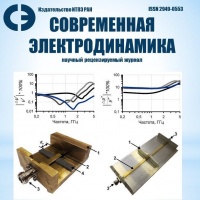
Section 1. Topics on theoretical electrodynamics
CONTROL OF LIGHT REFLECTION AND TRANSMISSION USING AN ACTIVE PLASMON METASURFACE
Klimov V. V.
Abstract
A new approach to the creation of meta-surfaces based on a combination of passive and active meta-atoms is proposed. The optical properties of such meta-surfaces have been studied. It is shown that with a certain choice of meta-surface parameters and changing the pump power, e ective switching between complete transmission and total re ection of light is possible.
Keywords: active meta-surfaces, meta-atoms, plasmonics, PT symmetry, exceptional points
Section 2. Topics on experimental electrodynamics
Ivanov P. A., Petrov D. A., Rozanov K. N.
Abstract
In uence of proximity of the sample to the short-circuit wall in the measurement of permeability and permittivity in a single-port stripline measurement cell has been numerically and experimentally investigated, in comparison to measurements in a dual-port stripline measurement cell. The comparison of the accuracy of di erent measurement methods was carried out using the Monte Carlo method and numerical nite element analysis. It is demonstrated that the measurement method based on the shorted single-port stripline measurement cell is capable of providing broadband measurements with high accuracy only for permeability. Accurate measurement of dielectric permittivity, on the other hand, is possible only within a narrow frequency range. In contrast, the dual-port line allows for broadband measurements with high accuracy for both material parameters.
Keywords: strip transmission lines, microwave measurements, permeability measurement, permittivity measurement, quasi-TEM approximation
Section 3. Topics on computer simulation in electrodynamics
FORMATION OF THE RADIATION PATTERN OF A BROADBAND ANTENNA FOR USING IT AS IRRADIATOR
Gilmutdinov R. V., Menshikh N. L., Solosin V. S., Fedorov S. A.
Abstract
In this paper options for upgrading the Satimo SH2000 broadband antenna by changing the shape of the ridge transition, using side walls and installing a phase corrector in the form of a diverging lens are presented. A computer model of the original antenna was created. It was experimentally con rmed that the developed electrodynamic model of the antenna makes it possible to obtain radiation characteristics with su cient accuracy. Using the method of integral equations in the FEKO software package, the in uence of types of antenna modi cations on the shape of the radiation pattern was studied. A comparison was made of the radiation patterns obtained as a result of modifying the antenna with the corresponding patterns of the original antenna in the frequency band. Three modi cations of the antenna are considered. The use of a phase corrector expands the radiation pattern in the E-plane. The use of small additional walls in the H-wall modi cation makes it possible to narrow the radiation pattern in the H-plane. The expanding ridge transition also contributes to the expansion of the radiation pattern in the E-plane, and makes it possible to reduce the asymmetry of the shape of the radiation pattern in the main planes. It is shown that upgrading the antenna makes it possible to create a radiation pattern that is more stable in shape and size in a frequency band with an overlap coe cient of more than two. The resulting shape of the radiation pattern allows us to consider the modernized antenna as a collimator irradiator.
Keywords: antenna Vivaldi, FEKO, irradiator, phase corrector, radiation pattern
Section 4. Metodological notes
QUASISTATIC (LOCALIZED) PLASMONS: FROM LANGMUIR TO FERRELL
Vinogradov A.P., Dorofeenko A.V.
Abstract
We review main results in electrostatic aspects of plasmonics. Although many applications of plasmonics require full-wave approach, plasmon resonance has an electrostatic nature. In this paper we focused on fundamentals of plasmonics, which are easier understood in the electrostatic approximation. We also touch upon a history of rst insights in resonances in subwavelength electromagnetic systems.
Keywords: plasmonics, localized plasmons, plasmon resonance, electrostatic approximation
COMMENT ON THE PAPER «ZUR QUANTENTHEORIE DER DISPERSION» BY A. SMECAL
Vinogradov A. P., Lisyansky A. A.
Abstract
The Smekal’s work is often seen as a background for the discovery of Raman scattering. The present note shows that although Smekal was one of the first to consider inelastic scattering of photons but the mechanism of inelasticity considered by Smecal is in no way related to either the intramolecular dynamics of the molecular nuclei nor the phenomenon of Raman scattering. The mechanism considered by Smekal is associated with the possibility of changing the state of the electronic subsystem during scattering. Moreover, the phenomenon studied by Smecal, in contrast to Raman scattering, can also be observed when light is scattered by usual atoms. The main focus of Smekal’s article is on the issue of recoil during photon emission. Taking into account the change in the kinetic energy of the molecule leads to additional inelasticity of scattering and makes it possible to obtain corrections to the well-known scattering formula by Kramers and Heisenberg. The translation of Smekal’s article into Russian and English is offered as an appendix.
Keywords: Raman scattering, inelasting scayyering, recoil during photon emission

Editorial address: 13 b. 6, Izhorskaya st.,
This site respects your rights and maintains confidentiality when filling out, transmitting and storing your confidential information.
Placing an application on this site means your consent to the processing of data and the further transfer of your contact information to our company.
Personal data means information related to the subject of personal data, in particular the name, contact details (email address) and other data classified as personal data by Federal Law of July 27, 2006 No. 152-FZ “On Personal Data.”
The purpose of processing personal data is to inform about the services provided by our company.
